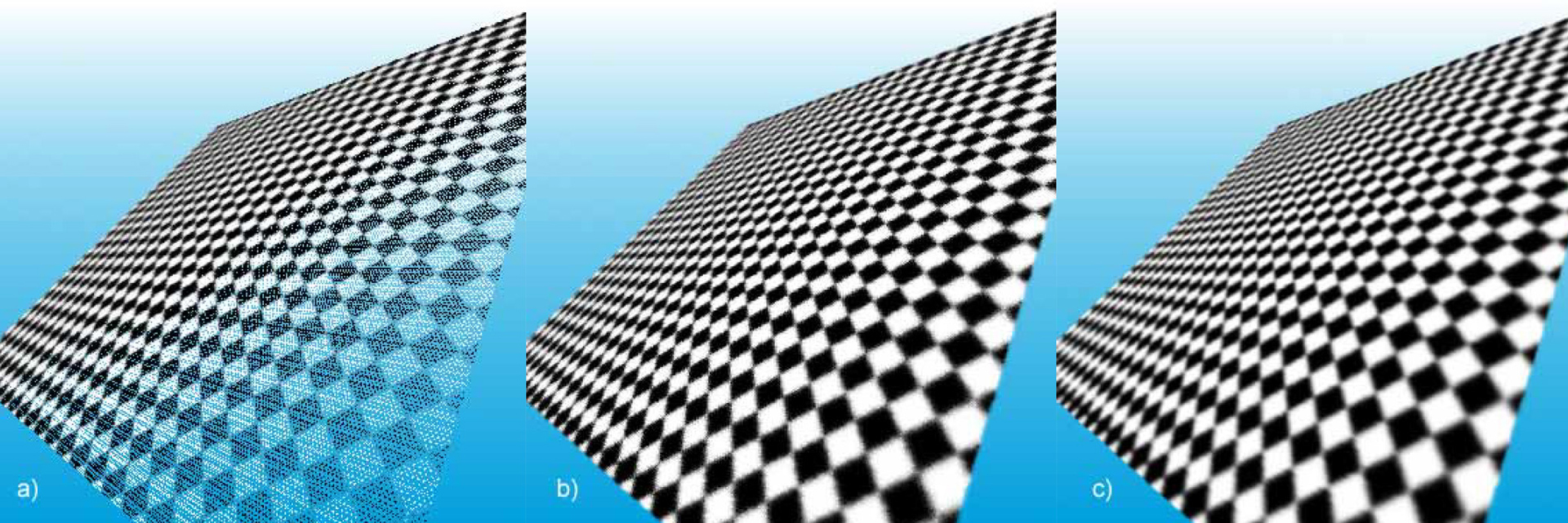“Surfels: surface elements as rendering primitives” by Pfister, Zwicker, van Baar and Gross
Conference:
Type(s):
Title:
- Surfels: surface elements as rendering primitives
Presenter(s)/Author(s):
Abstract:
Surface elements (surfels) are a powerful paradigm to efficiently render complex geometric objects at interactive frame rates. Unlike classical surface discretizations, i.e., triangles or quadrilateral meshes, surfels are point primitives without explicit connectivity. Surfel attributes comprise depth, texture color, normal, and others. As a pre-process, an octree-based surfel representation of a geometric object is computed. During sampling, surfel positions and normals are optionally perturbed, and different levels of texture colors are prefiltered and stored per surfel. During rendering, a hierarchical forward warping algorithm projects surfels to a z-buffer. A novel method called visibility splatting determines visible surfels and holes in the z-buffer. Visible surfels are shaded using texture filtering, Phong illumination, and environment mapping using per-surfel normals. Several methods of image reconstruction, including supersampling, offer flexible speed-quality tradeoffs. Due to the simplicity of the operations, the surfel rendering pipeline is amenable for hardware implementation. Surfel objects offer complex shape, low rendering cost and high image quality, which makes them specifically suited for low-cost, real-time graphics, such as games.
References:
1. Animatek. Caviar Technology. Web page. http://www.animatek.com/.
2. L. Carpenter. The A-buffer, an Antialiased Hidden Surface Method. In Computer Graphics, volume 18 of SIGGRAPH ’84 Proceedings, pages 103-108. July 1984.
3. E.E. Catmull. A Subdivision Algorithm for Computer Display of Curved Surfaces. Ph.D. thesis, University of Utah, Salt Lake City, December 1974.
4. C.F. Chang, G. Bishop, and A. Lastra. LDI Tree: A Hierarchical Representation for Image-Based Rendering. In Computer Graphics, SIGGRAPH ’99 Proceedings, pages 291-298. Los Angeles, CA, August 1999.
5. S.E. Chen. Quicktime VR – An Image-Based Approach to Virtual Environment Navigation. In Computer Graphics, SIGGRAPH ’95 Proceedings, pages 29-38. Los Angeles, CA, August 1995.
6. W. Dally, L. McMillan, G. Bishop, and H. Fuchs. The Delta Tree: An Object- Centered Approach to Image-Based Rendering. Technical Report AIM- 1604, AI Lab, MIT, May 1996.
7. M. Deering. Data Complexity for Virtual Reality: Where do all the Triangles Go? In IEEE Virtual Reality Annual International Symposium (VRAIS), pages 357-363. Seattle, WA, September 1993.
8. D. Ebert, F. Musgrave, D. Peachey, K. Perlin, and S. Worley. Texturing & Modeling -A ProceduraI Approach. AP Professional, second edition, 1994.
9. S. Gortler, R. Grzeszczuk, R. Szeliski, and M. Cohen. The Lumigraph. In Computer Graphics, SIGGRAPH ’96 Proceedings, pages 43-54. New Orleans, LS, August 1996.
10. L. Gritz. Blue Moon Rendering Tools. Web page. http://www.bmrt.org/.
11. J. R Grossman. Point Sample Rendering. Master’s thesis, Department of Electrical Engineering and Computer Science, MIT, August 1998.
12. J. R Grossman and W. Dally. Point Sample Rendering. In Rendering Techniques ’98, pages 181-192. Springer, Wien, Vienna, Austria, July 1998.
13. R Heckbert. Survey of Texture Mapping. IEEE Computer Graphics & Applications, 6(11):56-67, November 1986.
14. R Heckbert. Fundamentals of Texture Mapping and Image Warping. Master’s thesis, University of California at Berkeley, Department of Electrical Engineering and Computer Science, June 17 1989.
15. G.T. Herman. Discrete Multidimensional Jordan Surfaces. CVGIP: Graphical Modeling and Image P1vcessing, 54(6):507-515, November 1992.
16. A. Kaufman, D. Cohen, and R. Yagel. Volume Graphics. Computer, 26(7):51- 64, July 1993.
17. M. Levoy and R Hanrahan. Light Field Rendering. In Computer Graphics, SIGGRAPH ’96 Proceedings, pages 31-42. New Orleans, LS, August 1996.
18. M. Levoy and T. Whitted. The Use of Points as Display Primitives. Technical Report TR 85-022, The University of North Carolina at Chapel Hill, Department of Computer Science, 1985.
19. D. Lischinski and A. Rappoport. Image-Based Rendering for Non-Diffuse Synthetic Scenes. In Rendering Techniques ’98, pages 301-314. Springer, Wien, Vienna, Austria, June 1998.
20. N. Max. Hierarchical Rendering of Trees from Precomputed Multi-Layer Z- Buffers. In Rendering Techniques ’96, pages 165-174. Springer, Wien, Porto, Portugal, June 1996.
21. L. McMillan and G. Bishop. Plenoptic Modeling: An Image-Based Rendering System. In Computer Graphics, SIGGRAPH ’95 Proceedings, pages 39-46. Los Angeles, CA, August 1995.
22. V. Popescu and A. Lastra. High Quality 3D Image Warping by Separating Visibility from Reconstruction. Technical Report TR99-002, University of North Carolina, January 15 1999.
23. W.T. Reeves. Particle Systems – A Technique for Modeling a Class of Fuzzy Objects. In Computer Graphics, volume 17 of SIGGRAPH ’83 P~vceedings, pages 359-376. July 1983.
24. G. Schaufler. Per-Object Image Warping with Layered Impostors. In Rendering Techniques ’98, pages 145-156. Springer, Wien, Vienna, Austria, June 1998.
25. J. Shade, S. J. Gortler, L. He, and R. Szeliski. Layered Depth Images. In Computer Graphics, SIGGRAPH ’98 Proceedings, pages 231-242. Orlando, FL, July 1998.
26. A.R. Smith. Smooth Operator. The Economist, pages 73-74, March 6 1999. Science and Technology Section.
27. J. Torborg and J. Kajiya. Talisman: Commodity Real-Time 3D Graphics for the PC. In Computer Graphics, SIGGRAPH ’96 Proceedings, pages 353-364. New Orleans, LS, August 1996.
28. D. Voorhies and J. Foran. Reflection Vector Shading Hardware. In Computer Graphics, Proceedings of SIGGRAPH 94, pages 163-166. July 1994.
29. L. Westover. Footprint Evaluation for Volume Rendering. In Computer Graphics, Proceedings of SIGGRAPH 90, pages 367-376. August 1990.





